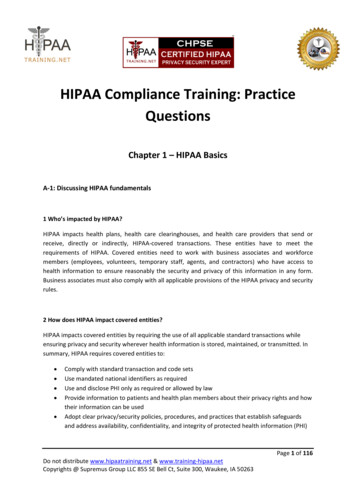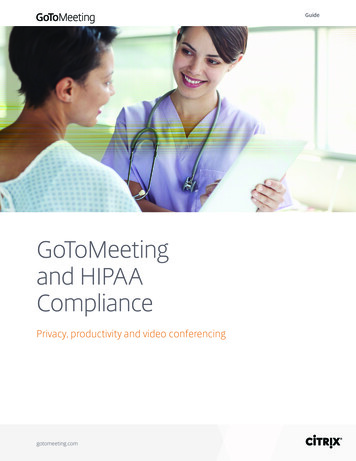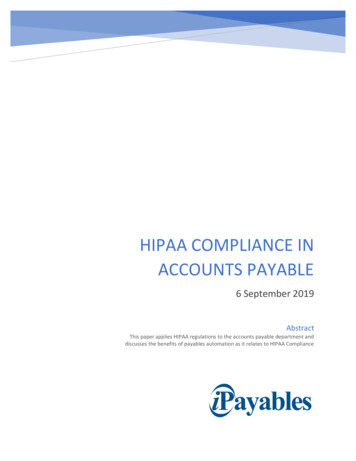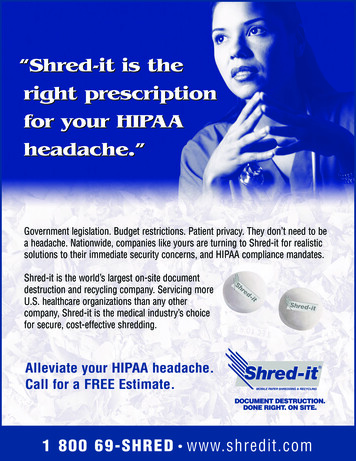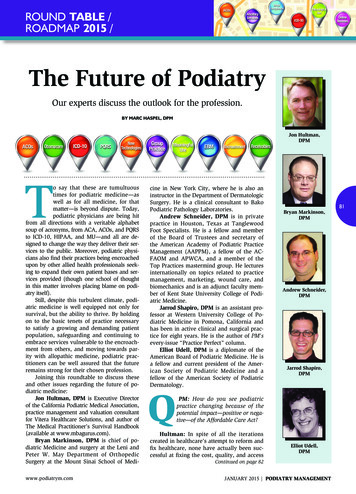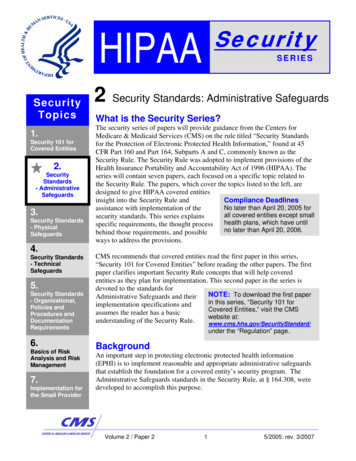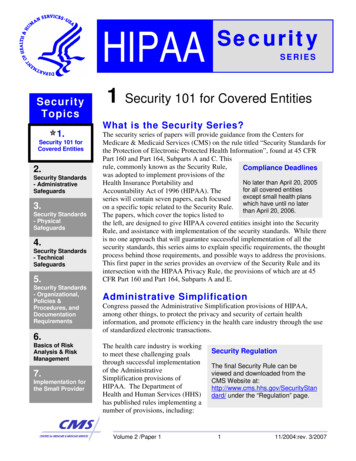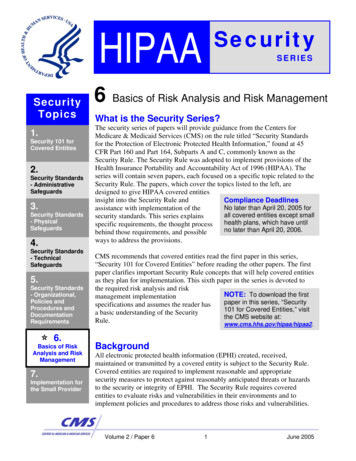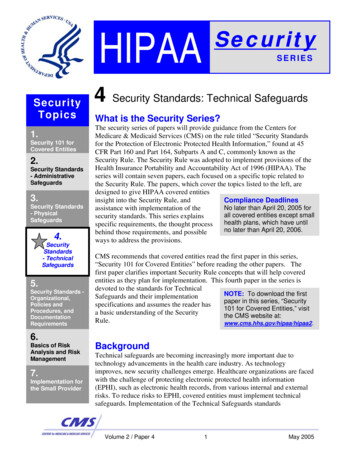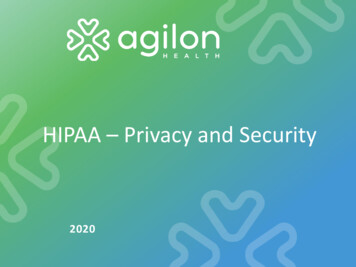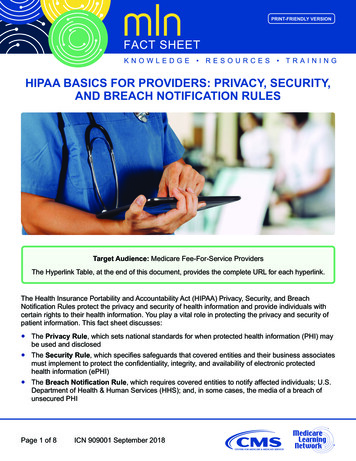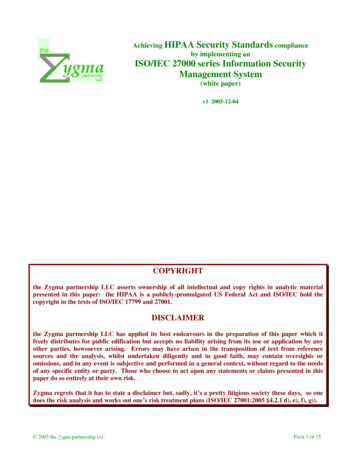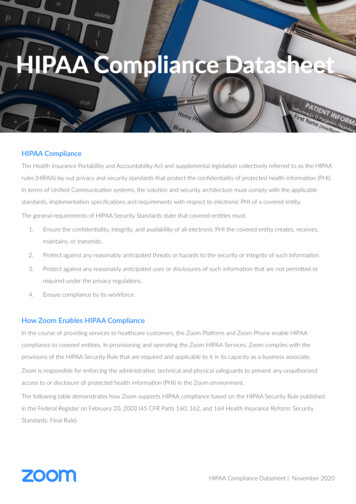
Transcription
HIPAA Compliance DatasheetHIPAA ComplianceThe Health Insurance Portability and Accountability Act and supplemental legislation collectively referred to as the HIPAArules (HIPAA) lay out privacy and security standards that protect the confidentiality of protected health information (PHI).In terms of Unified Communication systems, the solution and security architecture must comply with the applicablestandards, implementation specifications and requirements with respect to electronic PHI of a covered entity.The general requirements of HIPAA Security Standards state that covered entities must:1.Ensure the confidentiality, integrity, and availability of all electronic PHI the covered entity creates, receives,maintains, or transmits.2.Protect against any reasonably anticipated threats or hazards to the security or integrity of such information.3.Protect against any reasonably anticipated uses or disclosures of such information that are not permitted orrequired under the privacy regulations.4.Ensure compliance by its workforce.How Zoom Enables HIPAA ComplianceIn the course of providing services to healthcare customers, the Zoom Platform and Zoom Phone enable HIPAAcompliance to covered entities. In provisioning and operating the Zoom HIPAA Services, Zoom complies with theprovisions of the HIPAA Security Rule that are required and applicable to it in its capacity as a business associate.Zoom is responsible for enforcing the administrative, technical and physical safeguards to prevent any unauthorizedaccess to or disclosure of protected health information (PHI) in the Zoom environment.The following table demonstrates how Zoom supports HIPAA compliance based on the HIPAA Security Rule publishedin the Federal Register on February 20, 2003 (45 CFR Parts 160, 162, and 164 Health Insurance Reform: SecurityStandards; Final Rule).HIPAA Compliance Datasheet November 2020
HIPAA StandardHow Zoom Supports the StandardAccess Control: Implement technical policies and procedures for electronic information systems thatapplication layer using Advanced Encryptionmaintain electronic protected healthStandard (AES).information to allow access only to authorized persons or software programs. Unique User Identification: Assign a uniquetracking user identity. for obtaining necessary electronic healthinformation during an emergency. session after a predetermined time of Meetings are not listed publicly by Zoom. Zoom leverages a redundant and distributedarchitecture to offer a high level ofavailability and redundancy. setting does not affect the data at restEncryption and Decryption: Implement amechanism to encrypt and decrypt electronicprotected health information.Organizations can select data center regionsfor data in motion to your account. Thisinactivity. Meeting access is password protected bypassword or waiting room.Automatic Logoff: Implement electronicprocedures that terminate an electronicWeb and application access are protected byverified email address and password.Emergency Access Procedure: Establish(and implement as needed) proceduresMulti-layered access control for owner,admin, and members.name and/or number for identifying and Data in motion is encrypted at thestorage location. Meeting host can easily remove attendees orterminate meeting sessions. Host can lock a meeting in progress. Meetings end automatically with timeouts. Privacy features allow you to control sessionattendee admittance with individual or groupentry, waiting rooms, forced meeting testpasscodes, and locked room functionality.HIPAA Compliance Datasheet November 2020
Audit Controls: Implement hardware, software, and/or procedural mechanisms that record andexamine activity in information systems thatdistributed infrastructure. contain or use electronic protected healthinformation.Data in motion traverse Zoom’s secured andPlatform connections are logged for audioand quality-of-service purposes. Account admins have secured access tomanage individual, group, or organizationlevel management.Integrity: Implement policies and procedures to protect electronic protected health information fromimproper alteration or destruction.Multilayer integration protection is designedto protect both data and service layers. Controls are in place to protect and encryptmeeting data.Integrity Mechanism: Mechanism to authenticate electronic Application executables are digitally signed.protected health information. Data connections leverage TLS 1.2Implemented methods to corroborate thatencryption and PKI Certificates issued by ainformation has not been destroyed oftrusted commercial certificate authority.altered. Web and application access are protected byverified email address and password.HIPAA Compliance Datasheet November 2020
Person or Entity Authentication: Verify that the person or entity seeking access is the one claimed.Web and application access are protected byverified email and password. Meeting host must log in to Zoom using aunique email address and account password. Access to desktop or window for screensharing can be locked by host. Privacy features allow session attendeeadmittance with individual or group entry,waiting rooms, forced meeting passcodes,and locked room functionality.Transmission Security: Protect electronic health information that is stored on the Zoom platform. Integrity controls: Ensure that protectedData encryption protects against passive andactive attacks on confidentiality. Data connections leverage TLS 1.2health information is not improperly modifiedencryption and PKI Certificates issued by awithout detection.trusted commercial certificate authority.Encryption: Encrypt protected healthinformation. Zoom employs AES 256-GCM encryptionfor data to protect health information.Security and EncryptionHealthcare organizations and account administrators need to have the tools and technology to ensure they’re meetingHIPAA standards. Here are just a few safeguards that enable you to ensure the security and privacy of protected healthinformation (PHI). Data in motion is encrypted at the application layer using Advanced Encryption Standard (AES). Zoom Chat encryption allows for a secured communication where only the intended recipient can read thesecured message. Privacy features allow you to control session attendee admittance with individual or groupentry, waiting rooms, forced meeting passcodes, and locked room functionality.HIPAA Compliance Datasheet November 2020
Screen Sharing in HealthcareMedical professionals and authorized healthcare partners can use Zoom to meet with patients and other healthcareprofessionals to screen-share health records and other resources. Screen sharing transmits encrypted screen capturemouse and keyboard strokes.HIPAA CertificationCurrently, the agencies that certify health technology – the Office of the National Coordinator for Health InformationTechnology and the National Institute of Standards and Technology – do “not assume the task of certifying softwareand off-the-shelf products” (p. 8352 of the Security Rule), nor accredit independent agencies to do HIPAA certifications.Additionally, the HITECH Act only provides for testing and certification of Electronic Health Records (EHR) programs andmodules.Thus, as Zoom is not an EHR software or module, our type of technology is not certifiable by these unregulated agencies.Saying this, Zoom’s HIPAA Attestation was performed by a third party that reviewed and affirmed that Zoom implementsthe controls needed to secure protected health information (PHI) according to the requirements of the Health InsurancePortability and Accountability Act (HIPAA) Security Rule, Breach Notification Rule, and the applicable parts of the PrivacyRule. The Attestation was conducted in compliance with the American Institute of Certified Public Accountants (AICPA)Statement on Standards for Attestation Engagements (SSAE) 18, AT-C sections 105 and 205.Other Security CertificationSOC2:The SOC 2 report provides third-party assurance that the design of Zoom, and our internalprocesses and controls, meet the strict audit requirements set forth by the American Instituteof Certified Public Accountants (AICPA) standards for security, availability, confidentiality, andprivacy. The SOC 2 report is the de facto assurance standard for cloud service providers.HIPAA Compliance Datasheet November 2020
standards, implementation specifications and requirements with respect to electronic PHI of a covered entity. The general requirements of HIPAA Security Standards state that covered entities must: 1. Ensure the confidentiality, integrity, and availability of all electronic PHI the covered entity creates, receives, maintains, or transmits. 2.
